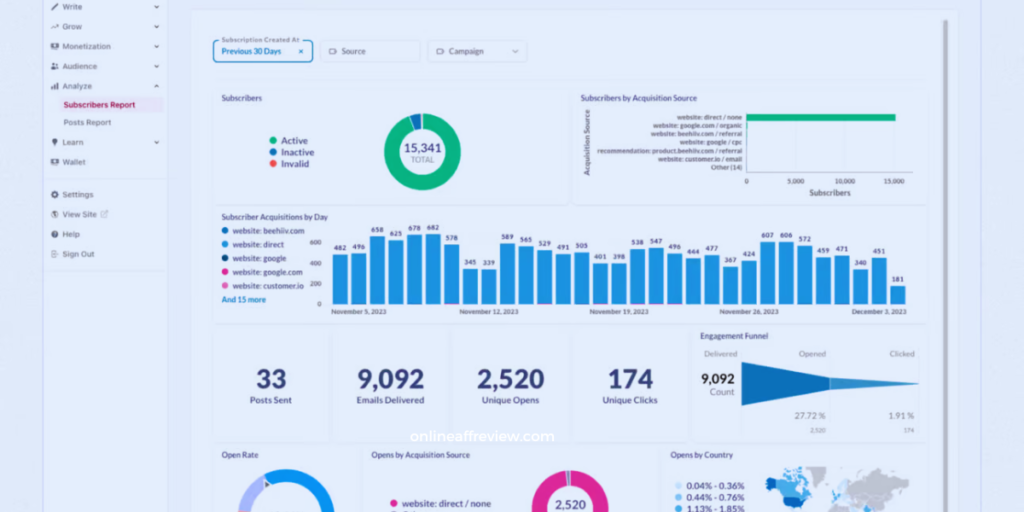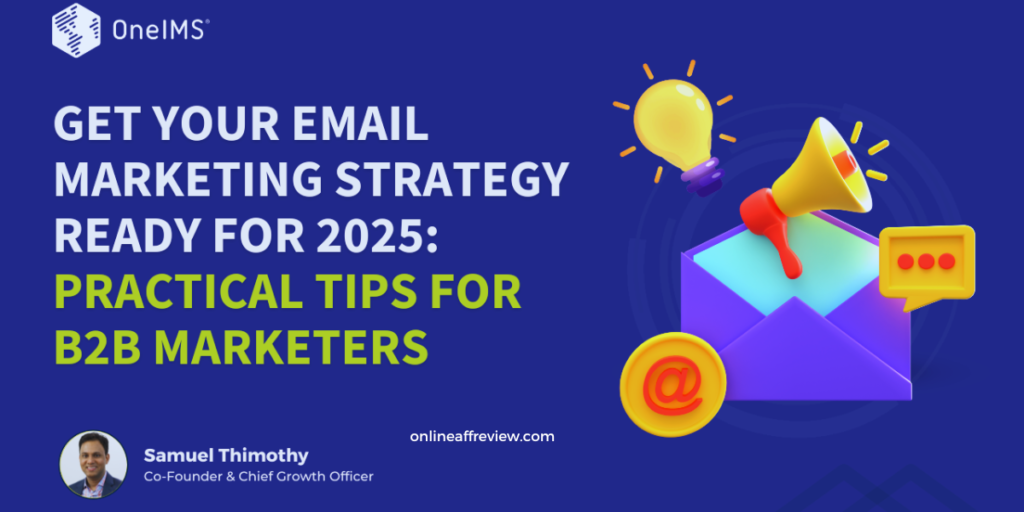Let’s face it—email marketing is one of the most powerful tools businesses have to connect with their audience. And guess what? Starting an email marketing agency gives you the chance to help companies thrive while building something incredible for yourself. It’s a win-win situation; honestly, it’s not as intimidating as it might seem at first glance.
The secret to success lies in following proven strategies that set you apart from the crowd. In this post, we’ll focus on three game-changing tactics: creating compelling case studies to showcase your expertise, networking strategically to grow your connections, and using social media to build your brand and attract clients. These steps will not only help you stand out but also lay the groundwork for a thriving agency. Ready to dive in? Let’s make it happen! Click here to learn more.
GetResponse: Try for free

Publish Case Studies to Build Credibility
When it comes to starting an email marketing agency, trust is everything. Potential clients want to know that you can deliver results—and there’s no better way to prove your worth than by showcasing real-world success stories. That’s where case studies come in. They don’t just highlight what you’ve done—they show how you solved problems and delivered measurable outcomes for your clients. In short, they build credibility and set you apart from the competition.
How to Create Compelling Case Studies
The key to a great case study is making it relatable, actionable, and results-driven. Here’s how to craft one that grabs attention:
- Choose Successful Campaigns or Projects
Start by selecting campaigns or projects that truly demonstrate your skills. Maybe you helped a small business boost their email open rates or designed a killer welcome sequence that drove sales. Whatever it is, make sure it’s something you’re proud of and that highlights your expertise. - Include Measurable Outcomes
Numbers speak louder than words. Use data to show the impact of your work. For example:- “Increased open rates by 50% in just three months.”
- “Generated $10,000 in sales from a single email campaign.”
These metrics give potential clients a clear idea of what you can achieve for them.
- Tell a Story
People love stories, so structure your case study like one. Break it down into three parts:- The Problem : What challenge was the client facing? (e.g., low engagement, poor conversions).
- The Solution : How did you address it? Walk through your strategy, tools, and execution.
- The Results : Share the outcome and include those impressive numbers. Keep it concise but engaging—like you’re telling a friend about a recent win.
Where to Share Your Case Studies
Once you’ve created your case studies, it’s time to get them in front of the right people. Here are some effective ways to share them:
- Your Website’s Portfolio Section : This is prime real estate for showcasing your work. Make sure your case studies are easy to find and well-organized.
- Social Media Platforms : Turn your case studies into bite-sized content for platforms like LinkedIn, Instagram, or even Twitter. For example, create a carousel post on Instagram or a professional update on LinkedIn highlighting the key takeaways.
- Guest Blogs or Industry Publications : Pitch your case studies as articles to blogs or publications in your niche. It’s a great way to reach a wider audience and position yourself as an expert.
Pro Tip: Start Small if You’re Just Beginning
If you’re new to the game and don’t have a ton of client work under your belt, don’t worry—you can still create impactful case studies. Offer free or discounted services to a few businesses in exchange for permission to document the process and results. Not only will this help you build your portfolio, but it’ll also give you valuable experience to refine your skills.

Network Strategically to Grow Your Reach
Let’s be honest—relationships are the backbone of any successful business, and your email marketing agency is no exception. Networking isn’t just about handing out business cards or adding people on LinkedIn; it’s about building genuine connections that can lead to partnerships, referrals, and long-term client relationships. When done right, networking can open doors you didn’t even know existed.
How to Network Effectively
The key to effective networking is being intentional and proactive. Here are some practical ways to grow your network:
- Attend Industry Events
Whether it’s a local meetup, a national conference, or a virtual summit, industry events are goldmines for meeting like-minded professionals. Look for events focused on digital marketing, entrepreneurship, or your specific niche (e.g., e-commerce or SaaS). These are perfect opportunities to learn, share ideas, and connect with potential clients or collaborators. - Join Online Communities
The internet has made networking easier than ever. Join groups or communities where your target audience hangs out:- LinkedIn Groups : Participate in discussions about email marketing trends or ask thoughtful questions to engage with others.
- Facebook Groups : Many industries have active groups where business owners and marketers share advice and support.
- Slack Channels : Find niche-specific Slack communities where you can build relationships in a more casual setting.
- Collaborate with Complementary Businesses
You don’t have to do everything alone. Partnering with businesses that offer complementary services—like web designers, SEO experts, or social media managers—can be a win-win. For example, a web designer might refer clients to you for email campaigns, while you send leads their way for website development. These partnerships can help both of you grow faster.
Tips for Meaningful Connections
Networking isn’t just about showing up—it’s about making an impact. Here’s how to build relationships that last:
- Be Genuine and Focus on Helping Others
People can tell when you’re only in it for yourself. Instead of immediately pitching your services, take the time to listen and understand their needs. Ask questions like, “What challenges are you facing with your marketing?” or “How can I support you?” Offering help first builds trust and makes people more likely to recommend you down the line. - Follow Up After Meetings
A quick follow-up can make all the difference. After meeting someone at an event or connecting online, send a personalized message to solidify the connection. For example:- “It was great chatting with you about your email strategy. I’d love to share some resources that might help!”
- “Thanks for the introduction to your team—I’ll follow up next week to discuss how we can collaborate.”
- Offer Value First
Before asking for anything in return, give something valuable. Share a helpful article, introduce them to someone in your network, or offer a free consultation. When you consistently provide value, people remember you—and they’re more likely to refer clients your way.
\Networking isn’t about collecting contacts—it’s about cultivating meaningful relationships that benefit everyone involved. By attending events, joining communities, collaborating with others, and focusing on genuine connections, you’ll create a network that supports your agency’s growth for years to come.
Read More:
Leverage Social Media to Showcase Your Expertise
In today’s digital world, social media isn’t just a place to scroll—it’s a powerful tool for growing your email marketing agency. Platforms like LinkedIn, Instagram, and Twitter give you direct access to your target audience, allowing you to establish authority, build trust, and attract clients. The key is using these platforms strategically to position yourself as the go-to expert in email marketing.
How to Use Social Media Effectively
To make the most of social media, focus on providing value and engaging with your audience. Here’s how:
- Share Valuable Content
People follow experts who teach them something new. Share content that educates, inspires, or entertains:- Post tips: Share actionable advice, like “5 Ways to Improve Your Email Open Rates.”
- Highlight trends: Discuss the latest in email marketing, such as AI-driven personalization or interactive emails.
- Give behind-the-scenes looks: Show snippets of your process, like how you design an email template or craft a winning subject line.
- Engage With Your Audience
Social media is a two-way street. Don’t just post and disappear—interact with your followers:- Respond to comments: Whether it’s a question or a compliment, reply promptly and thoughtfully.
- Answer questions: Jump into discussions or host Q&A sessions to address common pain points.
- Participate in conversations: Join relevant threads or hashtags to share your insights and connect with others.
- Use Visuals to Stand Out
Let’s face it—people love visuals. Use eye-catching graphics, videos, or infographics to explain complex topics in a digestible way. For example:- Create a carousel post breaking down the anatomy of a high-converting email.
- Share a short video explaining the importance of segmentation.
- Design an infographic comparing open rates across industries.
Platform-Specific Strategies
Each social media platform has its own vibe, so tailor your approach accordingly:
- LinkedIn : This is the place to get professional. Share thought leadership articles, post updates about your campaigns, and connect with decision-makers. For example, write a post about “The Biggest Mistakes I See in Email Marketing (And How to Fix Them).”
- Instagram : Focus on creativity and storytelling. Use Stories, Reels, and carousel posts to educate and entertain. For instance, create a Reel showing a “before and after” of an email campaign redesign.
- Twitter : Keep it short and snappy. Share quick tips, join trending conversations, and engage with influencers in your niche. A tweet like “Your subject line is the first impression—make it count!” can spark meaningful interactions.
Pro Tip: Consistency Is Key
Social media success doesn’t happen overnight. To build trust and stay top-of-mind, post regularly and maintain a cohesive brand voice. Whether it’s sharing weekly tips or posting monthly case studies, consistency shows your audience that you’re reliable and committed to delivering value.
By leveraging social media effectively, you’ll not only showcase your expertise but also create opportunities to connect with potential clients and collaborators. Remember, it’s not about being everywhere—it’s about being strategic and making an impact where your audience spends their time.
Leverage Social Media to Showcase Your Expertise
In today’s digital world, social media isn’t just a place to scroll—it’s a powerful tool for growing your email marketing agency. Platforms like LinkedIn, Instagram, and Twitter give you direct access to your target audience, allowing you to establish authority, build trust, and attract clients. The key is using these platforms strategically to position yourself as the go-to expert in email marketing.
How to Use Social Media Effectively
To make the most of social media, focus on providing value and engaging with your audience. Here’s how:
- Share Valuable Content
People follow experts who teach them something new. Share content that educates, inspires, or entertains:- Post tips: Share actionable advice, like “5 Ways to Improve Your Email Open Rates.”
- Highlight trends: Discuss the latest in email marketing, such as AI-driven personalization or interactive emails.
- Give behind-the-scenes looks: Show snippets of your process, like how you design an email template or craft a winning subject line.
- Engage With Your Audience
Social media is a two-way street. Don’t just post and disappear—interact with your followers:- Respond to comments: Whether it’s a question or a compliment, reply promptly and thoughtfully.
- Answer questions: Jump into discussions or host Q&A sessions to address common pain points.
- Participate in conversations: Join relevant threads or hashtags to share your insights and connect with others.
- Use Visuals to Stand Out
Let’s face it—people love visuals. Use eye-catching graphics, videos, or infographics to explain complex topics in a digestible way. For example:- Create a carousel post breaking down the anatomy of a high-converting email.
- Share a short video explaining the importance of segmentation.
- Design an infographic comparing open rates across industries.
Platform-Specific Strategies
Each social media platform has its own vibe, so tailor your approach accordingly:
- LinkedIn : This is the place to get professional. Share thought leadership articles, post updates about your campaigns, and connect with decision-makers. For example, write a post about “The Biggest Mistakes I See in Email Marketing (And How to Fix Them).”
- Instagram : Focus on creativity and storytelling. Use Stories, Reels, and carousel posts to educate and entertain. For instance, create a Reel showing a “before and after” of an email campaign redesign.
- Twitter : Keep it short and snappy. Share quick tips, join trending conversations, and engage with influencers in your niche. A tweet like “Your subject line is the first impression—make it count!” can spark meaningful interactions.
Pro Tip: Consistency Is Key
Social media success doesn’t happen overnight. To build trust and stay top-of-mind, post regularly and maintain a cohesive brand voice. Whether it’s sharing weekly tips or posting monthly case studies, consistency shows your audience that you’re reliable and committed to delivering value.
By leveraging social media effectively, you’ll not only showcase your expertise but also create opportunities to connect with potential clients and collaborators. Remember, it’s not about being everywhere—it’s about being strategic and making an impact where your audience spends their time.
Why This Version Feels Human:
- Friendly and Approachable Tone : Phrases like “Let’s face it” and “Social media is a two-way street” feel conversational and relatable.
- Actionable Examples : Specific ideas like “5 Ways to Improve Your Email Open Rates” or “before and after” Reels make the advice practical and easy to implement.
- Platform-Specific Tips : Tailoring strategies for LinkedIn, Instagram, and Twitter adds depth and shows readers exactly how to apply the advice.
- Emphasis on Engagement : Focusing on interaction and consistency feels authentic and reflects real-world social media practices.
Let me know if you’d like further tweaks or help with another section! 😊

Conclusion
Starting an email marketing agency might feel like a big leap, but with the right strategies, it’s absolutely within reach. Let’s recap what we’ve covered:
- Publishing case studies allows you to showcase real results and build trust with potential clients.
- Networking strategically helps you connect with decision-makers, collaborators, and referral partners who can fuel your growth.
- Leveraging social media gives you a platform to demonstrate your expertise, engage with your audience, and attract leads.
Now it’s your turn to take action. Whether it’s drafting your first case study, attending a networking event, or sharing your insights on social media, every small step moves you closer to your goal. Remember, success doesn’t happen overnight—but consistency and effort pay off.
With dedication and these strategies, you’ll be well on your way to building a thriving email marketing agency! So go ahead, take that first step today—you’ve got this!
FAQ : How to Start an Email Marketing Agency
- What skills do I need to start an email marketing agency?
You’ll need skills in email campaign strategy, copywriting, design, automation tools (e.g., Mailchimp, Klaviyo), analytics, and client communication. Certifications can also boost your credibility. - Do I need prior experience to start an agency?
Not necessarily! Offer free or discounted services initially to build case studies and gain experience. Focus on learning and delivering results. - How do I find my first clients?
Leverage your network, attend industry events, join online communities, and use social media to showcase your expertise. Offering value upfront helps attract early clients. - What tools are essential for email marketing?
Use platforms like Mailchimp, ActiveCampaign, or HubSpot for campaigns, Canva for design, and Google Analytics for tracking performance. - How important are case studies for my agency?
Very important! Case studies prove your expertise by showcasing real results, helping you win trust and attract new clients. - Should I focus on a specific niche?
Yes, specializing in a niche (e.g., e-commerce, SaaS) helps you stand out, target the right audience, and tailor your services effectively. - How can social media help grow my agency?
Social media allows you to share tips, engage with potential clients, and showcase your expertise through posts, Stories, Reels, and carousels. - How much should I charge for my services?
Pricing depends on your experience and services. Start with competitive rates (e.g., monthly retainers or project-based fees) and adjust as you grow. - How do I network effectively?
Attend events, join LinkedIn groups, and collaborate with complementary businesses. Focus on building genuine relationships rather than just selling. - How long does it take to see success?
Success varies but staying consistent with strategies like networking, publishing case studies, and leveraging social media can yield results within 6-12 months.

